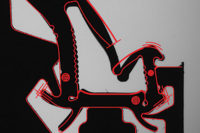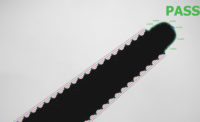
A composite view of a horizontal and vertical configuration a digital optical comparator is shown. Source: VisionX
Introduced in the 1940s, optical comparators are still being actively used to verify that manufactured parts are within tolerance, including those with complex geometries. Comparators are used throughout the plant including the shop floor, metrology and quality control labs. Optical comparators are versatile and robust, and provide an easy-to-use and cost-effective measurement solution for many applications and industries. Up until recently, comparators have been the easiest way to quickly compare a part to its drawing to allow the operator to make an overall pass/fail determination.
Today
Now, new digital advancements in comparator technology offer significant benefits. For example, new digital optical comparators offer the ability to digitally compare a part to its computer-aided design (CAD) data quickly and easily, at exceptionally high accuracy. This data also can be archived and documented electronically.In contrast, traditional optical comparators require Mylar overlay charts that are time consuming to use, less precise, error prone and difficult to document.
Also, because the CAD drawing can move with the part on a digital comparator, operators can compare a part to its CAD drawing beyond the optical field of view. With conventional optical comparators, the overlay is fixed on the screen and does not move when the stage carrying the part moves. Further, a digital optical comparator will automatically produce an operator-independent pass/fail result, and display any deviation from specification by comparing a part against bi-directional tolerances at user-specified control points.
New digital comparator technology combines the capabilities of an optical comparator, video coordinate measurement machine, machine vision and vision system. Similar to a coordinate measuring machine (CMM), digital optical comparators produce highly accurate measurements in both manual and full automated modes. The latest comparators feature an extensive set of machine vision tools to carry out pattern matching, color verification and defect detection. Very high-resolution imaging systems are now available, which provide detailed inspection of subjective properties, such as surface finish verification, digital image collection, annotation and electronic distribution.
Today, operators can capture a very high resolution and geometrically exact image of the part by using a high-resolution digital camera and low distortion telecentric lens. And they can easily view the high contrast images in full daylight.
Monitors also are improving. High-resolution quad monitors produce images with an on-screen resolution better than that of traditional 30-inch optical comparators.
Digital comparator technology is appropriate for a range of industries including orthopedics, medical device manufacturing, automotive, aerospace, energy, precision mechanical components and assemblies. It also is appropriate for higher magnification and very high accuracy applications such as micro electro-mechanical systems (MEMS) device manufacturing, electronics and semiconductor. For example, in the orthopedics industry, 100% of parts must be inspected and compared to their CAD data during the manufacturing process, directly on the shop floor. These are implants with complex geometries and tight tolerances. The higher accuracy that digital comparator technology provides is a key benefit.
Also, because parts can be made in small batches, there is a constant need to change the overlay. With traditional optical comparators, this involves removing the overlay, walking over to the overlay storage area, finding the correct overlay, walking back to the machine and positioning the overlay.
With digital technology, the operator only needs to scan in the work order’s barcode or press a button on the screen to automatically call up the correct overlay, which comes up already correctly positioned over the image of the part.

A digital optical comparator overlays the part’s CAD drawing onto the live video image of the part, in this case, the part is a knee implant. Source: VisionX
Moving Forward
As comparator technology continues to evolve to address market demands, data collection and automation are vital considerations. Operators will require that optical comparators have much more extensive data collection capabilities. And obviously, it will be expected that the data be in electronic form.Up until now, optical comparators have not had any built-in data collection capability. As a result, the records of most inspection operations carried out using optical comparators are information-poor and of uneven quality.
This is understandable as many of these inspections are carried out directly on the shop floor, by machine operators whose primary function is to manufacture parts. Inspection records kept in these circumstances often consist of a checkmark or two on a paper report, indicating that the necessary inspection has indeed been carried out successfully. These types of records are not up to today’s documentation and record keeping standards.
With digital optical comparator technology, when the operator scans in the barcode on the router that accompanies the parts to be inspected, not only does the system automatically load the correct CAD file, but all of the relevant information-for example, lot and job numbers, work order and operator identifier-also is directly linked. The system can then be used to quickly obtain a high accuracy auto pass/fail result to compare the part to its CAD file.
This operator-independent result, along with any measurements of critical dimensions and other notes can be saved along with a very high-resolution image of the part and its CAD file overlay, and a time/date stamp.
And all of this is done on the shop floor, as the parts are being inspected at the different stages of the manufacturing process. The quality of the information being collected is tremendously increased, and at the same time, the cost of collecting this comprehensive information is reduced.
Automation also is of significant importance. Manual comparator systems can produce results that may vary from operator to operator. Fully-automated operations provide much higher accuracy results and eliminate variation due to operator dependency.
There are a number of benefits and no downsides to better, more extensive data collection and increased automation. With the growing requirements made on manufacturers today for higher yields and ever-increasing quality, electronic data collection and automation are the way of the future for optical comparators.


